Spatial Equity of PM2.5 Pollution Exposures in High-Density Metropolitan Areas Based on Remote Sensing, LBS and GIS Data: A Case Study in Wuhan, China
Abstract
1. Introduction
2. Literature Review
2.1. Air Pollution Exposure Study Coupled with the Spatio-Temporal Behavior of Residents
2.2. Group Differences in Air Pollution Exposure and Environmental Justice Studies
2.3. Inadequacy of Existing Studies
3. Research Data and Methods
3.1. Study Area
3.2. Study Data
3.3. Study Methods
3.3.1. Measurement of PM2.5 Concentration
3.3.2. PM2.5 Measurement under the Spatial and Temporal Activities of the Residents
- (1)
- Measurement of PM2.5 pollution exposure in urban space based on residents’ spatial and temporal activities.
- (2)
- PM2.5 pollution exposure measurement of urban population based on residents’ spatial and temporal activities.
3.3.3. Walk Score
- (1)
- Measurement of basic walking index.
- (2)
- Measurement of the single-point walking index.
- (3)
- Measurement of the surface area walking index.
4. Results
4.1. Spatial Pattern of PM2.5 Pollution Exposure
4.2. PM2.5 Pollution Exposure for Different Age Groups
- (1)
- The exposure risk of the elderly (65 years old and above) was higher than that of other age groups.
- (2)
- Communities with high exposure risk for the elderly were concentrated around the center and sub-center of the city.
- (3)
- The exposure risk of children (0–6 years old) was not significantly different from that of the other age groups.
- (4)
- Communities with high exposure and high risk of children were scattered in the suburbs of the city, showing a high outer and low inner distribution.
- (5)
- The risk of PM2.5 pollution exposure was relatively low in the working-age population (19–59 years).
- (6)
- Cluster distribution of communities with high exposure risk for working-age people outside the first ring.
4.3. Health Equity within Vulnerable Populations
- (1)
- Among vulnerable groups, a few bore higher exposure risks.
- (2)
- Spatial heterogeneity in areas with high exposure risk.
- (3)
- High internal and low external exposure risk for the elderly and high internal and low external exposure risk for children.
5. Discussion
- (1)
- Neighborhoods at high risk of PM2.5 pollution among the elderly are mainly located in high-intensity built-up areas in the city center, for which, in conjunction with China’s ongoing urban renewal initiatives, this study proposes a morphology-guided, functionally mixed strategy. We propose that the guidance of block texture and morphology should be used, an urban ventilation system should be constructed, the internal ventilation corridor of the block should be built, and the internal ventilation corridor should be linked with the urban ventilation corridor to form a “sewage system”. Improving the mix of functions can reduce the travel distance and the probability of motor vehicle travel for urban residents, and reduce the total carbon emission and path exposure of residents’ travel;
- (2)
- The common feature of typical high-risk areas for PM2.5 pollution exposure for the elderly and children is the insufficient construction of green and open spaces. The study proposes the strategy of increasing their extent, improving planning, and optimizing the layout. A scattered layout should be avoided in the process of configuring green space, and the centralization and scale of green space should be promoted. Regarding the layout of green and open space, the layout should be optimized according to the functional characteristics;
- (3)
- As a road connecting urban areas, the trunk road is characterized by high traffic volume and high pollution. In the dense area of the trunk road network, the study proposes the protection retreat line restriction function strategy. During the construction process, the threshold distance of significant reduction of pollutants on both sides of the road should be calculated as the basis of the protection retreat line. Strict functional construction restrictions should be made in the high concentration range to avoid crowd-gathering spaces such as schools, residences, and open spaces from being too close to the main roads to reduce the risk of PM2.5 pollution exposure;
- (4)
- During the construction of new cities, emphasis should be placed on the integration of industries and cities, and the location of large industrial enterprises should not only focus on industrial benefits but should also consider ecological benefits. The residential land of large industrial enterprises should be close to large ecological spaces to reduce industrial waste gas pollution to the residents. At the same time, adequate protective measures should be set up outside the industrial land of concentrated scale to guide the pollutants to stop their diffusion to the isolation and absorption green belt and avoid their flow to the crowd-gathering space.
6. Conclusions
Author Contributions
Funding
Institutional Review Board Statement
Informed Consent Statement
Data Availability Statement
Conflicts of Interest
References
- Yuan, M.; Song, Y.; Huang, Y.; Hong, S.; Huang, L. Exploring the Association between Urban Form and Air Quality in China. J. Plan. Educ. Res. 2018, 38, 413–426. [Google Scholar] [CrossRef]
- Yuan, M.; Huang, Y.; Shen, H.; Li, T. Effects of urban form on haze pollution in China: Spatial regression analysis based on PM2.5 remote sensing data. Appl. Geogr. 2018, 98, 215–223. [Google Scholar] [CrossRef]
- Pope, C.; Dockery, D. Health effects of fine particulate air pollution: Lines that connect. J. Air Waste Manag. Assoc. 2006, 56, 707–708. [Google Scholar] [CrossRef] [PubMed]
- Apte, J.S.; Marshall, J.D.; Cohen, A.J.; Brauer, M. Addressing Global Mortality from Ambient PM2.5. Environ. Sci. Technol. 2015, 49, 8057–8066. [Google Scholar] [CrossRef]
- Zou, B.; Xu, S.; Zhang, J. Spatial Variation Analysis of Urban Air Pollution Using GlS: A Land Use Perspective. Geomat. Inf. Sci. Wuhan Univ. 2017, 42, 216–222. [Google Scholar]
- Xu, S.; Zou, B.; Hu, C. Urban scene-oriented simulation of the spatial distribution of PM2.5 concentration in an intra-urban area at fine scale. China Environ. Sci. 2019, 39, 4570–4579. [Google Scholar]
- China Ecological Environment Status Bulletin 2020; Excerpt; Environmental Protection; Ministry of Ecology and Environment: Beijing, China, 2021; Volume 49, pp. 47–68.
- Liu, K.; Wu, Y.; Wang, X.-Y.; Wang, C.-X. Impact of spatial structure of urban agglomerations on air pollution in China. China Popul. Resour. Environ. 2020, 30, 28–35. [Google Scholar]
- Reis, S.; Liska, T.; Vieno, M.; Carvell, E.J.; Beck, R. The Influence of Residential and Workday Population Mobility on Exposure to Air Pollution in the UK. Environ. Int. 2018, 121 Pt 1, 803–813. [Google Scholar] [CrossRef] [PubMed]
- Laatikainen, T.E.; Hasanzadeh, K.; Kyttä, M. Capturing exposure in environmental health research: Challenges and opportunities of different activity space models. Int. J. Health Geogr. 2018, 17, 29. [Google Scholar] [CrossRef] [PubMed]
- Dewulf, B.; Neutens, T.; Lefebvre, W.; Seynaeve, G. Dynamic assessment of exposure to air pollution using mobile phone data. Int. J. Health Geogr. 2016, 15, 14. [Google Scholar] [CrossRef] [PubMed]
- Park, Y.M.; Kwan, M.P. Individual exposure estimates may be erroneous when spatiotemporal variability of air pollution and human mobility are ignored. Health Place 2017, 43, 85–94. [Google Scholar] [CrossRef] [PubMed]
- Gariazzo, C.; Pelliccioni, A.; Bolignano, A. A dynamic urban air pollution population exposure assessment study using model and population density data derived by mobile phone traffic. Atmos. Environ. 2016, 131, 289–300. [Google Scholar] [CrossRef]
- Zhao, P.; Kwan, M.-P.; Zhou, S. The Uncertain Geographic Context Problem in the Analysis of the Relationships between Obesity and the Built Environment in Guangzhou. Int. J. Environ. Res. Public Health 2018, 15, 308. [Google Scholar] [CrossRef] [PubMed]
- Chen, X.; Feng, J.; Pnina, P. Urban Health Equity from the Exposure Perspective: A Case Study of Nanjing. Urban Rural. Plan. 2018, 3, 31–37. [Google Scholar]
- Ma, X.; Li, X.; Kwan, M.-P.; Chai, Y. Who Could Not Avoid Exposure to High Levels of Residence-Based Pollution by Daily Mobility? Evidence of Air Pollution Exposure from the Perspective of the Neighborhood Effect Averaging Problem (NEAP). Int. J. Environ. Res. Public Health 2020, 17, 1223. [Google Scholar] [CrossRef]
- Guo, W.; Zhang, Y.; Chai, Y. Measurement of residents’ daily travel air pollution exposure and its mechanism: A case study of suburban communities in Beijing. Geogr. Res. 2015, 34, 1310–1318. [Google Scholar]
- Chen, B.; Song, Y.; Jiang, T. Real-Time Estimation of Population Exposure to PM 2.5 Using Mobile- and Station-Based Big Data. Int. J. Environ. Res. Public Health 2018, 15, 573. [Google Scholar] [CrossRef]
- Baldelli, A. Evaluation of a low-cost multi-channel monitor for indoor air quality through a novel, low-cost, and reproducible platform. Meas. Sens. 2021, 17, 100059. [Google Scholar] [CrossRef]
- Castell, N.; Schneider, P.; Grossberndt, S.; Fredriksen, M.F.; Sousa-Santos, G.; Vogt, M.; Bartonova, A. Localized real-time information on air quality at kindergartens in Oslo, Norway using low-cost sensor nodes. Environ. Res. 2018, 165, 410–419. [Google Scholar] [CrossRef]
- Roca, D.; Lagüela, S.; Díaz-Vilariño, L.; Armesto, J.; Arias, P. Low-cost aerial unit for outdoor inspection of building façades. Autom. Constr. 2013, 36, 128–135. [Google Scholar] [CrossRef]
- Motlagh, N.H.; Zaidan, M.A.; Fung, P.L.; Li, X.; Matsumi, Y.; Petäjä, T.; Kulmala, M.; Tarkoma, S.; Hussein, T. November. Low-Cost Air Quality Sensing Process: Validation by Indoor-Outdoor Measurements. In Proceedings of the 2020 15th IEEE Conference on Industrial Electronics and Applications (ICIEA), Kristiansand, Norway, 9–13 November 2020; IEEE: Pistacaway, NJ, USA, 2020; pp. 223–228. [Google Scholar]
- Gu, L.; Rosenberg, M.; Zeng, J. The impacts of socioeconomic and environmental factors on self-rated health status among different income groups in China. Geogr. Res. 2017, 36, 1257–1270. [Google Scholar]
- Branis, M.; Linhartova, M. Association between unemployment, income, education level, population size and air pollution in Czech cities: Evidence for environmental inequality? A pilot national scale analysis. Health Place 2012, 18, 1110–1114. [Google Scholar] [CrossRef]
- Pearce, J.R.; Richardson, E.A.; Mitchell, R.J. Environmental justice and health: The implications of the socio-spatial distribution of multiple environmental deprivation for health inequalities in the United Kingdom. Trans. Inst. Br. Geogr. 2010, 35, 522–539. [Google Scholar] [CrossRef]
- Ma, J.; Liu, B.; Mitchell, G.; Dong, G.P. A spatial analysis of air pollution and environmental inequality in Beijing, 2000–2010. J. Environ. Plan. Manag. 2019, 62, 2437–2458. [Google Scholar] [CrossRef]
- Mitchell, G.; Dorling, D. An Environmental Justice Analysis of British Air Quality. Environ. Plan. A 2003, 35, 909–929. [Google Scholar] [CrossRef]
- Pearce, J.; Kingham, S. Environmental inequalities in New Zealand: A national study of air pollution and environmental justice. Geoforum 2008, 39, 980–993. [Google Scholar] [CrossRef]
- Meir, M. Race and Pollution Correlation as Predictor of Environmental Injustice. Bachelor’s Thesis, Duke University, Durham, NC, USA, 2013. [Google Scholar]
- Marshall, J.D. Environmental inequality: Air pollution exposures in California’s South Coast Air Basin. Atmos. Environ. 2008, 42, 5499–5503. [Google Scholar] [CrossRef]
- Lercher, P.; Pfeifer, C.; Botteldooren, D. Traffic noise exposure, education and annoyance: Longitudinal experience from crosssectional surveys over time (1989–2004). Proc. Forum Acusticum 2005, 1795–1799. Available online: http://hdl.handle.net/1854/LU-331155 (accessed on 16 September 2022).
- Boone, C.G.; Fragkias, M.; Buckley, G.L.; Grove, J.M. A long view of polluting industry and environmental justice in Baltimore. Cities 2014, 36, 41–49. [Google Scholar] [CrossRef]
- Chen, J.; Chen, S.; Landry, P.F. Migration, environmental hazards, and health outcomes in China. Soc. Sci. Med. 2013, 80, 85–95. [Google Scholar] [CrossRef]
- Brajer, V.; Hall, J.V. Changes in the Distribution of Air Pollution Exposure in the Los Angeles Basin from 1990 to 1999. Contemp. Econ. Policy 2005, 23, 50–58. [Google Scholar] [CrossRef]
- Park, Y.M.; Kwan, M.-P. Understanding Racial Disparities in Exposure to Traffic-Related Air Pollution: Considering the Spatiotemporal Dynamics of Population Distribution. Int. J. Environ. Res. Public Health 2020, 17, 908. [Google Scholar] [CrossRef] [PubMed]
- Fu, H.; Dai, J.; Gao, J.; Jia, Y.; Zhen, P. Healthy City Construction and Outlook. Healthy China Obs. 2019, 12, 72–74. [Google Scholar]
- Zhang, X.; Hu, G.; Shan, Z.; Li, H. Res-calling and politics of scale in China’s city-regional governance. Sci. Geogr. Sin. 2021, 41, 100–108. [Google Scholar]
- Shan, Z.; Zhang, X.; Huang, Y. The research on the spatial distribution layout of city permanent residents in metropolitan development area and main urban area in Wuhan: Based on the sixth census in 2010. Hum. Geogr. 2016, 31, 61–67. [Google Scholar]
- Chen, L.; Bai, Z.; Su, D.; You, Y.; Li, H.; Liu, Q. Application of land use regression to simulate ambient air PM10 and NO2 concentration in Tianjin City. China Environ. Sci. 2009, 29, 685–691. [Google Scholar]
- Chen, X.; Feng, J. Health effects of built environment based on a comparison of walkability and air pollution: A case study of Nanjing City. Prog. Geogr. 2019, 38, 296–304. [Google Scholar]
- Lu, Y.; Wang, D. Walkability Measuring in America and lts Enlightenment. Urban Plan. Int. 2012, 27, 10–15. [Google Scholar]
- Briggs, D.J. The Role of Gis: Coping with Space (and Time) in Air Pollution Exposure Assessment. J. Toxicol. Environ. Health 2005, 68, 1243–1261. [Google Scholar] [CrossRef]
- Briggs, D.J. Mapping Environmental Exposure. In Geographical and Environmental Epidemiology: Methods for Small-Area Studies; Oxford University Press: Oxford, UK, 1992; pp. 158–176. [Google Scholar]
- Pérez, P.; Trier, A.; Reyes, J. Prediction of PM 2.5 concentrations several hours in advance using neural networks in Santiago, Chile. Atmos. Environ. 2000, 34, 1189–1196. [Google Scholar] [CrossRef]
- Grivas, G.; Chaloulakou, A. Artificial neural network models for prediction of PM 10 hourly concentrations, in the Greater Area of Athens, Greece. Atmos. Environ. 2005, 40, 1216–1229. [Google Scholar] [CrossRef]
- Wang, M.; Zou, B.; Guo, Y.; He, J. BP artificial neural network-based analysis of spatial variability of urban PM2.5 concentration. Environ. Pollut. Control 2013, 35, 63–70. [Google Scholar]
- Zhang, X.; Chen, S.; Luan, X.; Yuan, M. Understanding China’s City-regionalization: Spatial Structure and Relationships between Functional and Institutional Spaces in the Pearl River Delta. Urban Geogr. 2020, 42, 312–339. [Google Scholar] [CrossRef]

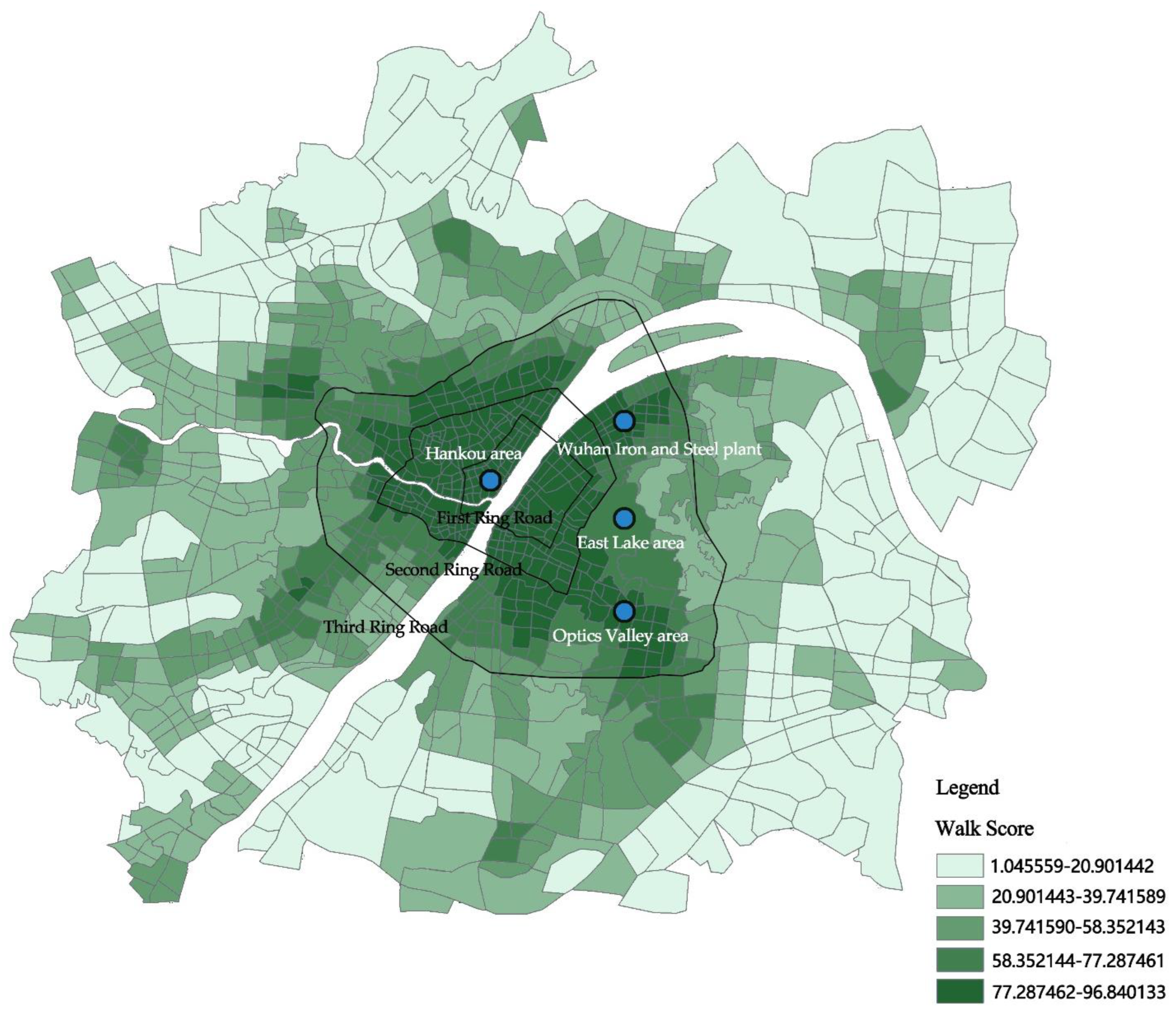
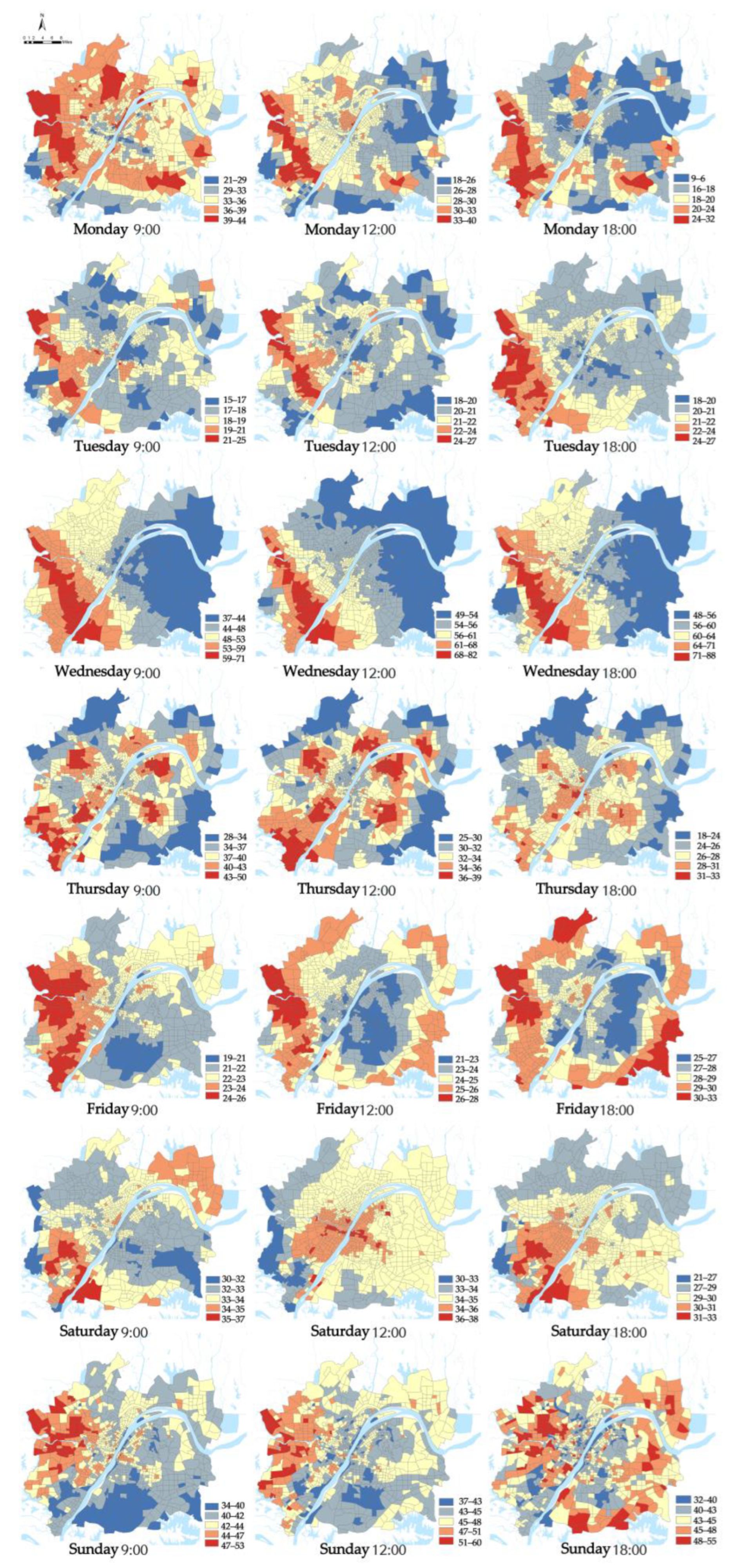
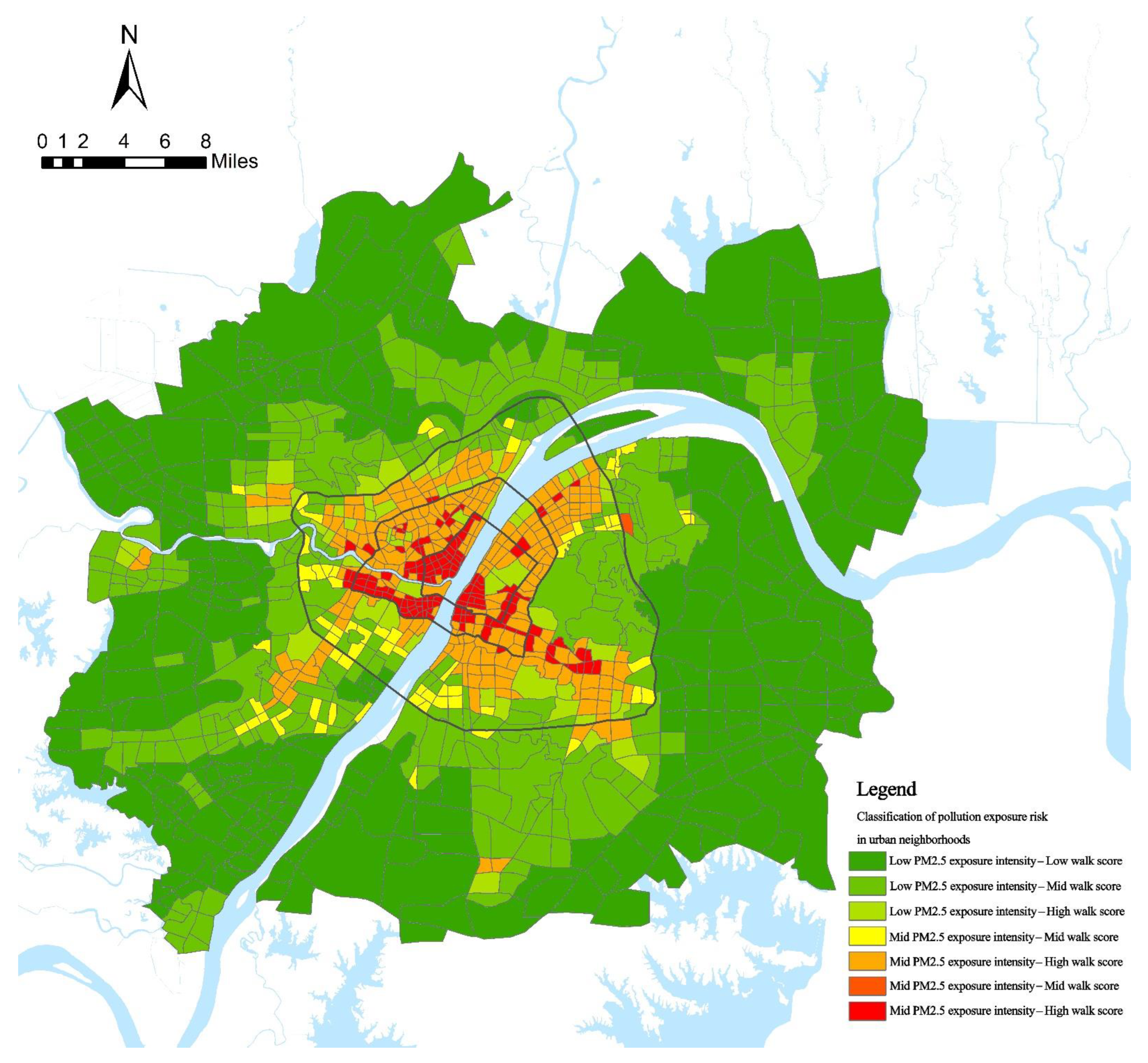
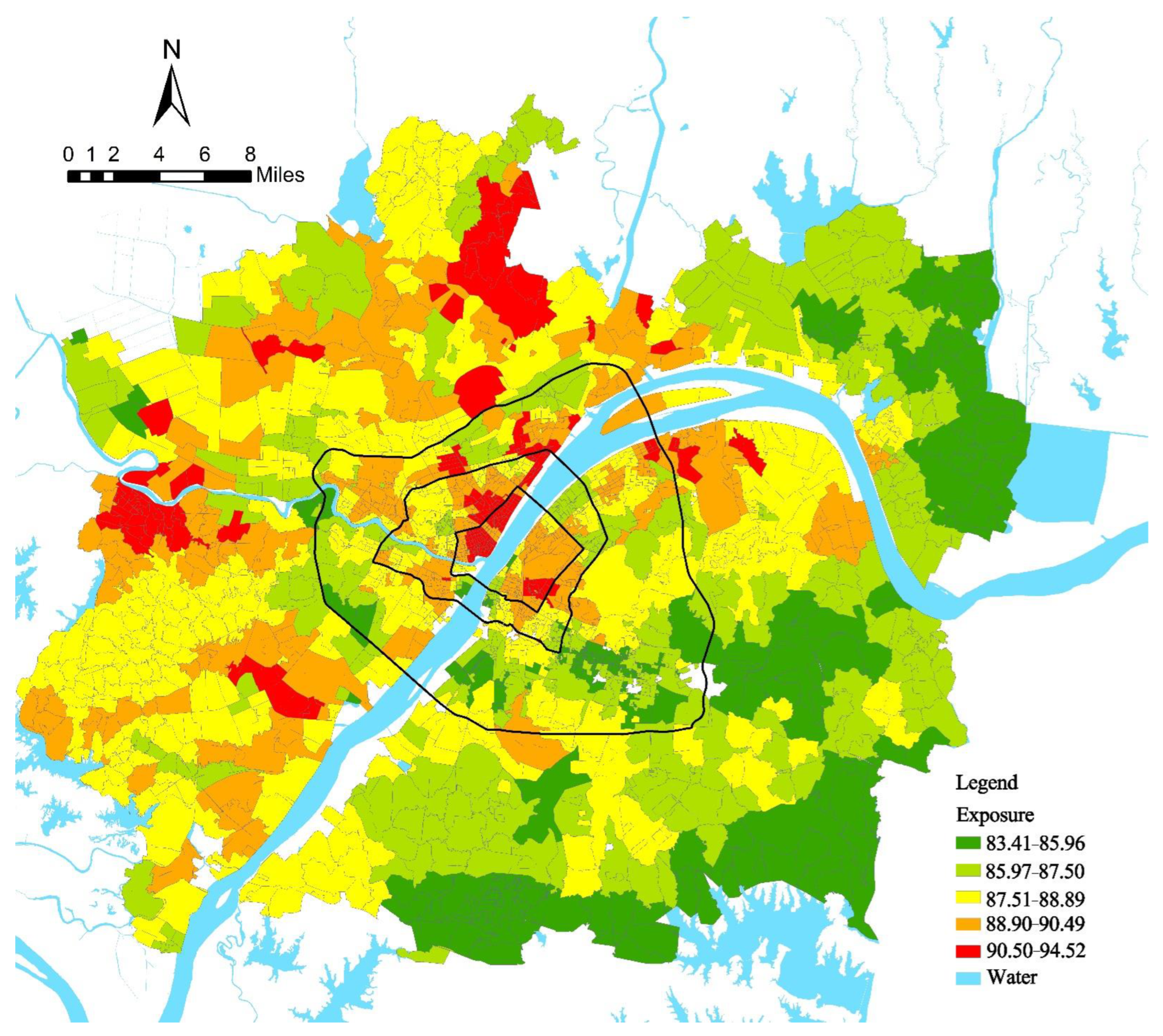

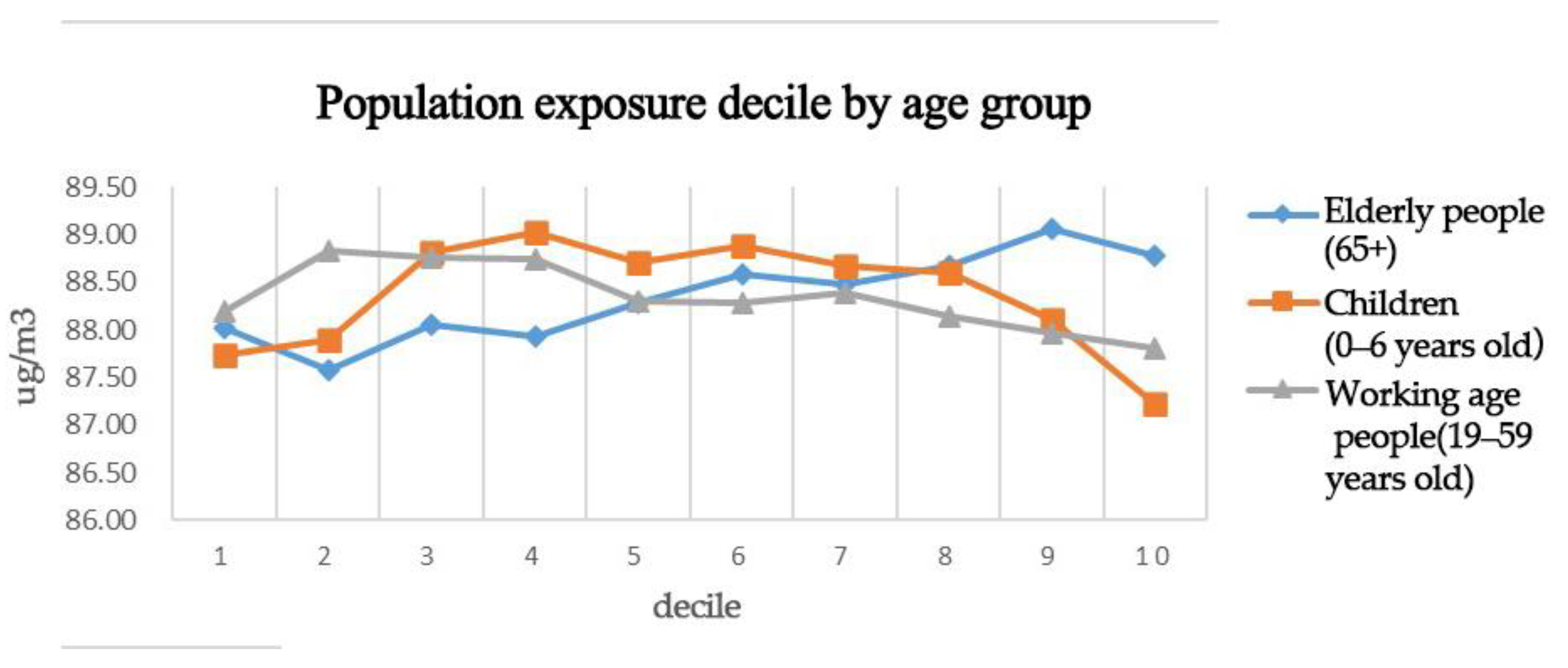


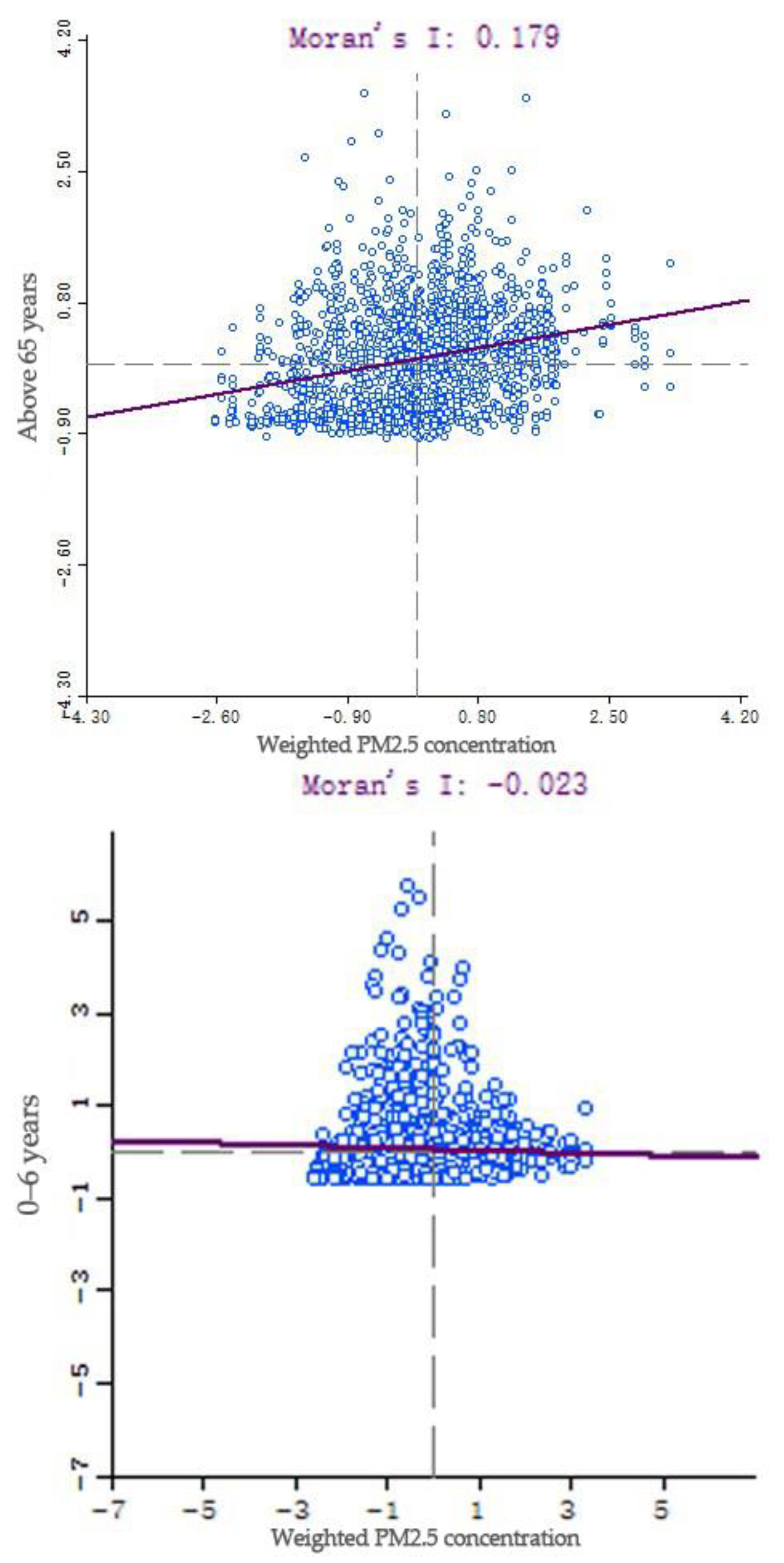

| Facility Classification | Name of Facility | Weights |
|---|---|---|
| Shopping | Grocery | 3 |
| Mall | 2 | |
| Dining | Restaurants | 3 |
| Café | 2 | |
| Leisure | Bookstore | 1 |
| Park | 1 | |
| Entertainment Venue | 1 | |
| Public Services | Hospital | 1 |
| School | 1 | |
| Bank | 1 | |
| Total | 16 |
| Block Length (m) | Decay Rate (%) | Intersection Density (Pcs/Square Mile) | Decay Rate (%) |
|---|---|---|---|
| <120 | 0 | >200 | 0 |
| 120–150 | 1 | 150–200 | 1 |
| 150–165 | 2 | 120–150 | 2 |
| 165–180 | 3 | 90–120 | 3 |
| 180–195 | 4 | 60–90 | 4 |
| >195 | 5 | <60 | 5 |
Publisher’s Note: MDPI stays neutral with regard to jurisdictional claims in published maps and institutional affiliations. |
© 2022 by the authors. Licensee MDPI, Basel, Switzerland. This article is an open access article distributed under the terms and conditions of the Creative Commons Attribution (CC BY) license (https://creativecommons.org/licenses/by/4.0/).
Share and Cite
Shan, Z.; Li, H.; Pan, H.; Yuan, M.; Xu, S. Spatial Equity of PM2.5 Pollution Exposures in High-Density Metropolitan Areas Based on Remote Sensing, LBS and GIS Data: A Case Study in Wuhan, China. Int. J. Environ. Res. Public Health 2022, 19, 12671. https://doi.org/10.3390/ijerph191912671
Shan Z, Li H, Pan H, Yuan M, Xu S. Spatial Equity of PM2.5 Pollution Exposures in High-Density Metropolitan Areas Based on Remote Sensing, LBS and GIS Data: A Case Study in Wuhan, China. International Journal of Environmental Research and Public Health. 2022; 19(19):12671. https://doi.org/10.3390/ijerph191912671
Chicago/Turabian StyleShan, Zhuoran, Hongfei Li, Haolan Pan, Man Yuan, and Shen Xu. 2022. "Spatial Equity of PM2.5 Pollution Exposures in High-Density Metropolitan Areas Based on Remote Sensing, LBS and GIS Data: A Case Study in Wuhan, China" International Journal of Environmental Research and Public Health 19, no. 19: 12671. https://doi.org/10.3390/ijerph191912671
APA StyleShan, Z., Li, H., Pan, H., Yuan, M., & Xu, S. (2022). Spatial Equity of PM2.5 Pollution Exposures in High-Density Metropolitan Areas Based on Remote Sensing, LBS and GIS Data: A Case Study in Wuhan, China. International Journal of Environmental Research and Public Health, 19(19), 12671. https://doi.org/10.3390/ijerph191912671






